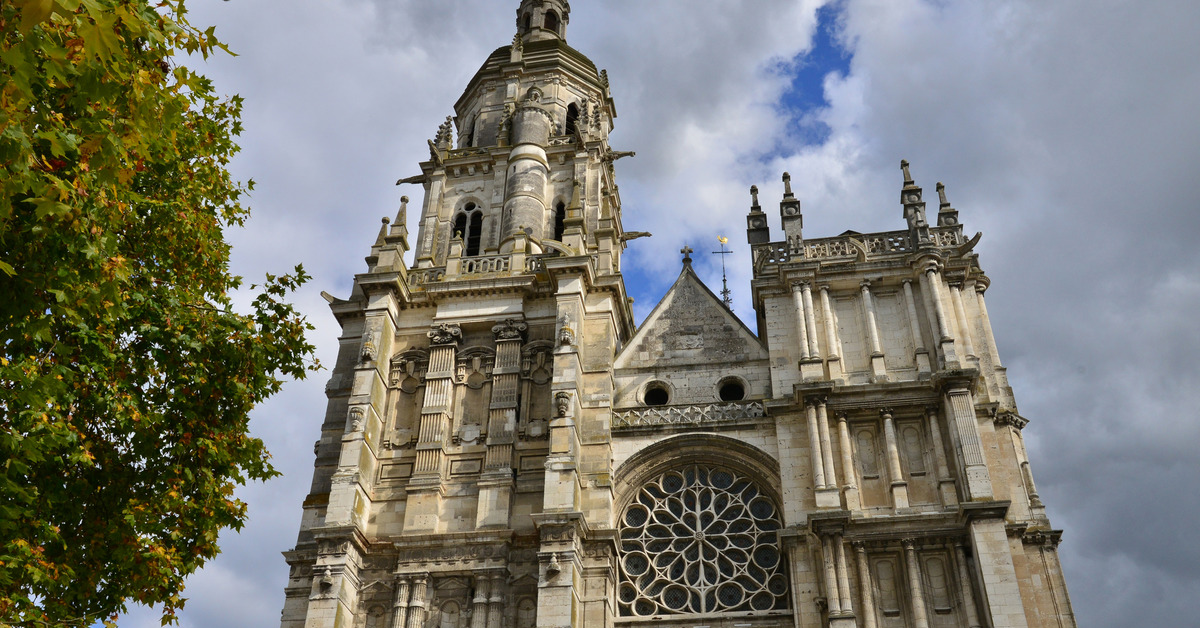Early last month Elaine and I did a preliminary reconnaissance for next June’s Normandy and Picardy tour. Starting in Chartres we followed William Morris’s route through Dreux, Evreux and Louviers to Rouen, revelling in those great gothic cathedrals which inspired not only Morris, but also Pugin, William Burges and others. Morris described the journey that he and Burne Jones made in a long letter to Cormell Price date August 10th, 1855, a severely truncated version of which I quote below:
Behold our itinerary. We started from Chartres quite early (six o’clock) with drizzling rain that almost hid the spires of the Cathedral, how splendid they looked in the midst of it! but we were obliged to leave them, and the beautiful statues and stained glass, and the great, cliff-like buttresses […] and went off, with the rain still falling a little, through the beautiful country to Dreux, for a distance of about 17 miles; there was plenty to look at by the road, I almost think I like that part of the country better than any other part of the lovely country we have seen in France; so gloriously the trees are grouped, all manner of trees, but more especially the gracious poplars and aspens, of all kinds; and the hedgeless fields of grain, and beautiful herbs […] looking as if they belonged to no man, as if they were planted not to be cut down in the end, and to be stored in barns and eaten by the cattle, but that rather they were planted for their beauty only.
So we went on through this kind of country till we came to Dreux, and the rain had cleared up long before we reached it, and it was a bright sunny day. […] Well, we had to stop at Dreux about an hour and we saw the church there, a very good one, flamboyant mostly, but with an earlier apse very evilly used, and with a transept front very elaborately carved once, now very forlorn and battered, but (Deo gratias) not yet restored: there is a delightful old secular tower at Dreux too, and that is flamboyant also, with a roof like the side of a cliff, it is so steep. So we left Dreux and set our faces as though we would go to Evreux; […] We had only a very short time to stay at Evreux, and even that short time we had to divide (alas ! for our Lower nature) between eating our dinner and gazing on the gorgeous Cathedral: it is an exceedingly lovely one, though not nearly so large as most of the Cathedrals we saw, the aisles are very rich flamboyant, with a great deal of light canopy work about them; the rest of the Church is earlier, the nave being Norman, and the choir fully developed early Gothic; though the transepts and lantern are flamboyant also by the way: […]
When we left Evreux we found that the country had changed altogether, getting much more hilly, almost as glorious in its way as the other land perhaps, but very different; […] so we kept on going, first winding up a long hill, then on a table land for a greater or lesser time, then down into the glorious lake-like valley, till at last we got to Louviers; there is a splendid church there, though it is not a large one; the outside has a kind of mask of the most gorgeous flamboyant (though late) thrown all over it, with such parapets and windows, it is so gorgeous and light, that I was utterly unprepared for the inside, and almost startled by it; so solemn it looked and calm after the fierce flamboyant of the outside; for all the interior, except the Chapels, is quite early Gothic and very beautiful; I have never, either before or since, been so much struck with the difference between early and late Gothic, and by the greater nobleness of the former.
So after we had looked at the Church for a little time we mounted the omnibus to go to the railway station where we were to take the train to Rouen – it was about 5 miles I should think from Louviers to the station. What a glorious ride that was, with the sun, which was getting low by that time, striking all across the valley that Louviers lies in; I think that valley was the most glorious of all we saw that day, […] it was all like the country in a beautiful poem, in a beautiful Romance such as might make a background to Chaucer’s Palamon and Arcite; how we could see the valley winding away along the side of the Eure a long way, under the hills: […] fancy, Crom, all the roads (or nearly all) that come into Rouen dip down into the valley where it lies, from gorgeous hills which command the most splendid views of Rouen. […] I had some kind of misgivings that I might be disappointed with Rouen, after my remembrances of it from last year; but I wasn’t a bit. O! What a place it is. I think Ted [Burne Jones] liked the Cathedral, on the whole, better than any other church we saw.”
Morris was, not surprisingly, right in his description of the church at Louviers: the West end is covered in a vast spider web of tracery, a masterpiece of the stonemason’s craft, while the interior retains the starkness and simplicity of early gothic. He was equally enthusiastic about Beauvais and Amiens, which we also visited and, despite the fact that the two World Wars ravaged much of this country, it is staggering what survives not just in terms of major cathedral architecture, but also in the half-timbered domestic streetscapes that surround them. Beauvais Cathedral Morris described as ‘one of the wonders of the world; seen at twilight its size gives one an impression almost of terror: one can scarcely believe in it.’ But it was the sight of Amiens Cathedral that decided him to abandon the study of theology in favour of architecture. It was also the great west porch of Amiens, adorned with a multiplicity of carvings of saints and other figures that inspired Ruskin to write his Bible of Amiens, which Proust later translated into French. Great as the west porch is, the sixteenth-century choir is almost more breath-taking, the stalls embellished with three-and-a-half thousand carved figures in oak. This is not generally accessible to the public, but the archivist has offered us a specially conducted visit. Just one of the personal touches that promise to make next June’s tour especially memorable.
I have concentrated here on the great Gothic Cathedrals, but as a stark contrast to the flamboyance, especially of Louviers, is the proto-modernism of Lutyen’s Le Bois des Moutiers and Maison des Communes at Varangeville-sur-Mer outside Dieppe, were we will be welcomed by the owners, but I will revert to them in detail in my next blog. The contrast between early, domestic, Lutyens – he was only twenty-eight when he designed Le Bois des Moutiers – and his War Memorials, especially the Memorial to the Missing at Thiepval is equally dramatic. Elaine and I are going to Arras – Cathedral eighteenth century – in a couple of weeks time to visit several of the major memorials, including Thiepval and Villers-Bretonneux, both by Lutyens; Herbert Baker’s Australian Memorial at Delville Wood and Indian Memorial at Neuve Chapel as well as Walter Seymour Allward’s Canadian War Memorial at Vimy Ridge.


